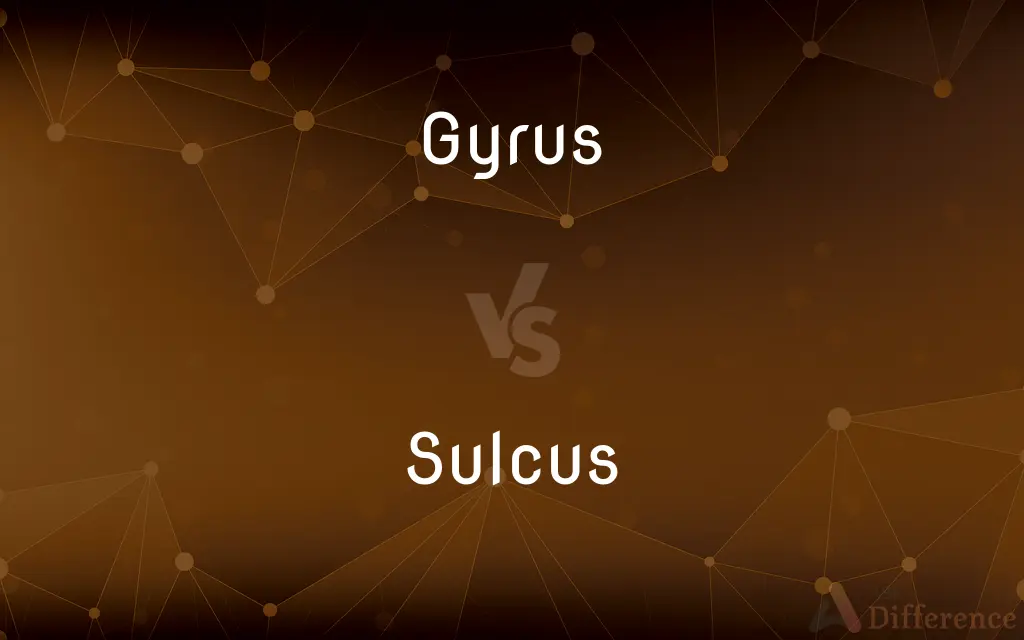Gyrus vs. Sulcus — What's the Difference?
By Tayyaba Rehman & Maham Liaqat — Updated on March 19, 2024
A gyrus is a ridge on the brain's surface, contributing to its wrinkled appearance; a sulcus is a groove or furrow that separates gyri, aiding in increasing the brain's surface area.

Difference Between Gyrus and Sulcus
Table of Contents
ADVERTISEMENT
Key Differences
A gyrus (plural: gyri) is an elevated ridge found on the surface of the brain. These ridges are part of the brain's cortex, increasing the surface area to accommodate more neurons. Whereas, a sulcus (plural: sulci) is a depression or groove in the cerebral cortex, serving to separate the gyri. The presence of gyri and sulci allows the brain to maximize its surface area within the limited volume of the skull.
Gyri are significant because they increase the brain's surface area, allowing for a higher density of neurons within a given volume. This increased neuron density is crucial for enhanced brain function and complexity. On the other hand, sulci play a critical role in delineating the various regions of the brain, facilitating the organization and mapping of different functional areas.
In terms of visibility and identification, gyri are the raised portions that can be seen on the surface of the brain, making them relatively easy to identify. In contrast, sulci are the intervening grooves that separate these ridges, and their depth can vary, with some being quite shallow and others being deep fissures.
The development of gyri and sulci begins early in fetal development and continues to evolve into early childhood. This development is part of the brain's natural growth and is essential for cognitive and motor function. Whereas the pattern of gyri and sulci is unique to each individual, certain major gyri and sulci are consistently found across humans, aiding in anatomical studies and neurological assessments.
The study of gyri and sulci has significant implications for understanding brain function and disorders. For example, abnormalities in the development of gyri and sulci can be indicators of neurological conditions. In contrast, sulci can sometimes be more affected in certain diseases, such as when sulcal widening is observed in brain atrophy.
ADVERTISEMENT
Comparison Chart
Definition
A ridge on the brain's surface.
A groove or furrow on the brain's surface.
Function
Increases the brain's surface area for more neurons.
Separates gyri, aiding in brain organization.
Visibility
Raised portions of the cerebral cortex.
Grooves or depressions separating gyri.
Role in Brain Development
Part of the brain's natural growth, increasing complexity.
Delineate brain regions, important for mapping functional areas.
Implications for Brain Function
Higher density of neurons enhances brain function.
Organizes brain regions, essential for neurological assessments.
Compare with Definitions
Gyrus
They contribute to the brain's cognitive capabilities.
Each gyrus contains neurons responsible for various brain functions.
Sulcus
Sulci help increase the brain's surface area indirectly.
Deep sulci contribute to a more compact and efficient brain structure.
Gyrus
Gyri are part of the cerebral cortex's anatomy.
Studying the gyri helps neuroscientists understand brain regions.
Sulcus
They are crucial for delineating brain regions.
The Sylvian sulcus marks the division between the temporal and frontal lobes.
Gyrus
Abnormalities in gyri can indicate neurological issues.
Abnormal gyrus patterns may be linked to developmental disorders.
Sulcus
Variations in sulci patterns can aid in brain mapping.
Neuroscientists use sulci to identify and map functional brain areas.
Gyrus
A raised ridge on the brain's surface, increasing its surface area.
The precentral gyrus is crucial for voluntary movement.
Sulcus
Sulcal abnormalities may indicate brain conditions.
Widening of sulci can be a sign of brain atrophy in various diseases.
Gyrus
Gyri are visible as the brain's convoluted ridges.
The gyri give the brain its characteristic wrinkled appearance.
Sulcus
A groove on the brain's surface that separates gyri.
The central sulcus separates the frontal and parietal lobes.
Gyrus
In neuroanatomy, a gyrus (pl. gyri) is a ridge on the cerebral cortex.
Sulcus
A deep, narrow furrow or groove, as in an organ or tissue.
Gyrus
A rounded ridge, as on the surfaces of the cerebral hemispheres.
Sulcus
Any of the narrow fissures separating adjacent convolutions of the brain.
Gyrus
(anatomy) A fold or ridge on the cerebral cortex of the brain.
Sulcus
(anatomy) A furrow or groove in an organ or a tissue, especially that marking the convolutions of the surface of the brain.
Gyrus
A convoluted ridge between grooves; a convolution; as, the gyri of the brain; the gyri of brain coral. See Brain.
Sulcus
(planetology) A region of subparallel grooves or ditches formed by a geological process.
Gyrus
A convex fold or elevation in the surface of the brain
Sulcus
A furrow; a groove; a fissure.
Sulcus
(anatomy) any of the narrow grooves in an organ or tissue especially those that mark the convolutions on the surface of the brain
Common Curiosities
Why are gyri important in the brain?
Gyri increase the brain's surface area, allowing for more neurons and enhanced brain functions.
Can the pattern of gyri and sulci vary between individuals?
Yes, while there are consistent patterns, the exact layout of gyri and sulci can vary between individuals.
How do gyri and sulci contribute to brain efficiency?
They increase the surface area within the limited volume of the skull, enhancing neuron density and brain efficiency.
Is there a correlation between the depth of a sulcus and brain function?
The depth can vary, and while not directly correlated with function, deeper sulci can contribute to more distinct brain region separation.
How do gyri and sulci develop?
They begin forming early in fetal development and continue to evolve into early childhood, contributing to cognitive and motor functions.
What role do sulci play in the brain?
Sulci separate gyri and help organize the brain into different functional areas.
Are abnormalities in gyri or sulci linked to neurological conditions?
Yes, abnormalities can indicate various neurological conditions and developmental disorders.
What distinguishes a gyrus from a sulcus?
A gyrus is a raised ridge on the brain, while a sulcus is a groove that separates gyri.
How are gyri and sulci identified in medical imaging?
Through techniques like MRI, gyri appear as raised areas, and sulci as grooves, aiding in neurological assessment.
Do all mammals have gyri and sulci?
Many mammals have gyri and sulci, but the complexity varies, with humans having one of the most complex patterns.
How do gyri and sulci affect brain volume?
They do not directly affect volume but increase surface area for neural networks within the given volume.
Can the function of a brain region be determined by its gyri and sulci?
While specific functions are not determined solely by gyri and sulci, their patterns help map functional areas.
Are gyri and sulci static throughout life?
Their basic structure is relatively stable, but changes can occur due to growth, aging, and neurological conditions.
What is the significance of the central sulcus?
It separates the frontal and parietal lobes, marking a critical functional division in the brain.
What happens to gyri and sulci as we age?
Aging can lead to changes, such as sulcal widening, which is associated with brain volume loss in some conditions.
Share Your Discovery

Previous Comparison
Bicycle vs. Bike
Next Comparison
Monarchy vs. CommunismAuthor Spotlight
Written by
Tayyaba RehmanTayyaba Rehman is a distinguished writer, currently serving as a primary contributor to askdifference.com. As a researcher in semantics and etymology, Tayyaba's passion for the complexity of languages and their distinctions has found a perfect home on the platform. Tayyaba delves into the intricacies of language, distinguishing between commonly confused words and phrases, thereby providing clarity for readers worldwide.
Co-written by
Maham Liaqat













































